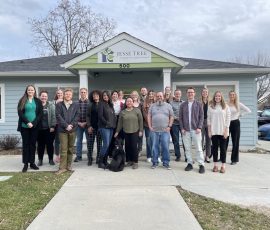It can feel like visiting a foreign country, each with its own language, culture, and systems, but the cross-cultural effort is well worth it!
by Pauline Fong • July 2017
 In the summer of 1990 I was in Sofia, the capital city of Bulgaria. Only six months before, throngs of East and West Germans swarmed the Berlin Wall with hammers and chisels, marking the fall of the Iron Curtain in the region. I was experiencing both the dramatic changes affecting Eastern Europe first-hand, and Bulgarian culture for the first time. The dark espresso from roadside coffee carts that I sipped each morning wakened me to the beauty of the ancient city of Sofia, with its Ottoman architecture and cobblestone streets. We consumed large blocks of feta cheese, salami and creamy yogurt for breakfast, and I had never even heard of feta cheese before. People nodded their heads to say “No,” and shook their heads from side to side to communicate “Yes.” On more than one occasion, I embarrassed myself by shaking my head the wrong way!
In the summer of 1990 I was in Sofia, the capital city of Bulgaria. Only six months before, throngs of East and West Germans swarmed the Berlin Wall with hammers and chisels, marking the fall of the Iron Curtain in the region. I was experiencing both the dramatic changes affecting Eastern Europe first-hand, and Bulgarian culture for the first time. The dark espresso from roadside coffee carts that I sipped each morning wakened me to the beauty of the ancient city of Sofia, with its Ottoman architecture and cobblestone streets. We consumed large blocks of feta cheese, salami and creamy yogurt for breakfast, and I had never even heard of feta cheese before. People nodded their heads to say “No,” and shook their heads from side to side to communicate “Yes.” On more than one occasion, I embarrassed myself by shaking my head the wrong way!
While I deeply appreciated those new experiences, I also felt the inevitable dissonance of crossing cultures, which at times included feelings of frustration, misunderstanding, confusion, tension, anger and, yes, embarrassment. I wasn’t always able to understand or articulate what I was feeling, but I certainly felt the discomfort inherent in cross-cultural encounters. Today, I see many similarities as nonprofit leaders and funders seek to collaborate with partnerships to serve the common good. While a great opportunity to learn from distinctly different perspectives, experiences and expertise, the process can at times feel a little like crossing into a new country and can create confusion and uncertainty, not unlike the experience of living abroad.
For instance, when nonprofits start navigating a grant proposal process with a funder, the wording of grants can feel like a foreign space. Having been a nonprofit leader for more than 20 years before coming to the M. J. Murdock Charitable Trust, I vividly remember encountering the unfamiliar world of foundations and grants for the first time as a potential grantee. I recall learning the new language of LOIs and Pro Formas—a completely new set of terms, systems and processes.
The cross-cultural challenges can be felt by both sides. Funders interact with nonprofits of many shapes and sizes and from many different sectors. Each nonprofit’s language, culture and system can also feel like a foreign space for the staff of a foundation. For example, not only does each nonprofit handle financials differently—categorizing earned versus contributed income, depreciating or not depreciating assets—but staff positions and titles often mean different things in different organizations. For one, a regional director might oversee four states; in another, a regional director leads a county, with different roles and varying degrees of responsibility in an organization.
In addition to the cultural differences of language, systems and processes between nonprofits and funders, inherent dynamics of power and privilege also come into play. Not only are there dynamics of funder and (potential) grantee, we also often work across multiple layers of differences in our backgrounds—urban/rural, gender, racial, ethnic, educational, socio-economic, amongst others. Any of these differences are potential barriers as we seek to partner together for the common good.
I remember one nonprofit that serves a population of mostly immigrants talking about why Medicaid is not one of their main earned income streams as one might expect. Many of their clients are reluctant to register and provide their information to the government, they explained, due to the political realities (both current and also in their home countries). At first glance, it may seem like the organization is overly reliant on contributed income and had not pursued a logical source of earned income. Yet, it makes perfect sense once one understands the systems, power and differences at work in their context.
So given these challenges, how can we navigate these dynamics and differences as we work with one another for the common good?
While it is not possible to explore, here in this blogpost, the many complexities and nuances of navigating dynamics of power and privilege in specific situations, below I’ve listed five basic suggestions for both nonprofits and funders:
- Approach with graciousness: It is natural to feel apprehensive when approaching a new partnership and cross-cultural situations with layers of power dynamics. However, remember and believe in everyone’s desire for the shared goal of working together for the common good. Approach the situation with graciousness (meaning kindness and a generosity of spirit), rather than suspicion and fear.
- Do your homework: Read up on the potential partner’s websites. Use the limited time you have to learn and prepare for the interaction. Learn the basics and prepare questions and anticipate potential cultural differences.
- Pay attention to power dynamics: All relationships, whether they are between individuals or organizations, have power dynamics. Ask questions of yourself to unearth them. Who and what structural power differentials are at play here? What dimensions of privilege(s) are present? There may be multiple power dynamics present. It is incumbent upon those with power and privilege to choose humility. I am not talking about being a doormat. Humility means choosing to respect and esteem others. Left to our natural instincts, we are prone to pride and self-importance. Choose humility—believe that others may see something you don’t see and have a perspective that you can learn from.
- Ask, don’t assume. Inquire about what you observe. Double check to make sure you understand, rather than assuming you know what something means. Refrain from the temptation to judge or criticize, to rationalize or defend. These tendencies are natural under cross-cultural stress, but it does not mean we have to give into them.
- Listen well: Practice active listening. Mirror back or rephrase what you hear. Ask follow-up and clarifying questions.
- Repeat: Repeat the observing, asking, and listening, especially when you notice feelings of tension rising, either in yourself or in others.
Cross-cultural interactions are fraught with challenges. Without the proper preparation and sensitivity, cross-cultural encounters can end in alienation, withdrawal and broken relationships. However, the beauty of cross-cultural relationships is that, though difficult, they can lead to greater understanding of the world that we live in and the richness of different experiences, perspectives, gifts and insights. These riches yield the gifts of new or deeper relationships, enhancing collaboration and enabling us to serve together for the common good. The value and beauty of these relationships are deeply needed by our world today and are well worth facing the challenges. So, as we embark on the adventure of crossing cultures for the sake of working together for the common good, I say, “Nazdrave!” (“Cheers!” if your Bulgarian is a little rusty!)
Pauline Fong is a program director with the M.J. Murdock Charitable Trust.








